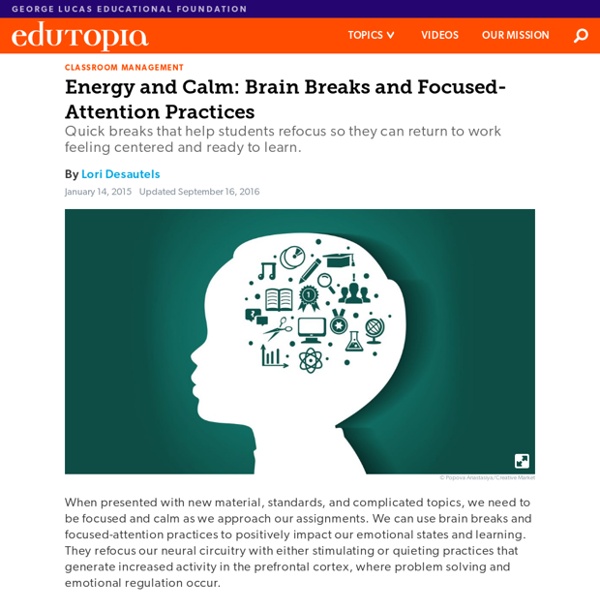Energy and Calm: Brain Breaks and Focused-Attention Practices

https://www.edutopia.org/blog/brain-breaks-focused-attention-practices-lori-desautels
Related: Classroom Hacks
• Pedagogy
• angelacroix
• Evidence-based Practice
22 classroom systems that make my teaching easier
My name is Deanna Roberts and I’m a third grade ELA/SS teacher in Ohio. As a lifelong perfectionist and overachiever, the club has helped me achieve a healthier work-life balance and has changed my life for the better. I am much more intentional and productive during work hours thanks to the strategies I’ve learned in the club.
12 Principles Of Modern Learning -
12 Principles Of Modern Learning by TeachThought Staff What are the principles of modern learning? Well, that depends on how you define ‘learning’ and what you’d consider ‘modern.’ Richard Olsen put together this useful visual way, way back in 2013–a chart that lays out three categories of a modern approach to learning–Modern, Self-Directed, and Social.
Adapting materials for mixed ability classes
In these cases it’s important to remember that all students will get something out of the class, but not necessarily the same things, and not necessarily what you aim to teach them! For example, the beginners may begin to get a grasp of your classroom language whilst the stronger students may begin to be able to put a new tense into use. Adapting materials for mixed ability classes can take different forms. One way to adapt materials is to rewrite reading texts and grade the language accordingly for different levels. In an ideal world where a teacher has all the time in the world to prepare their classes this may be the perfect solution. However, the reality is that this sort of adaptation is extremely time consuming and not many teachers can actually go to this length to adapt materials for mixed level groups.
Are these the 7 pillars of classroom practice?
There are two main problems with the idea that teachers should be reading research. The first is that they don’t have time to do it (see bit.ly/UnreadResearch). Studies by the Education Endowment Foundation (EEF) have examined methods of encouraging teachers to engage with academic research but report that time pressures – and a lack of opportunities for teachers to work together – appear to undermine the initiatives. So, if we genuinely want teaching to be a research-informed profession, we should reduce the number of hours we expect teachers to work – and ultimately set aside some time for teachers to read and apply research to their practice. The second problem is actually finding research related to the questions we have as teachers. Searching through academic journals can be a frustrating and often fruitless investment of time and effort.
15 of the Best Brain Breaks
Brain breaks are a great classroom management tool to use regularly in your classroom. Brain breaks are short, 1 to 2 minute, activities that can give students a break from school work. Brain breaks give students a chance to get up and move around. Brain breaks can even happen in the middle of a lesson. I love to use brain breaks as a way to break up the subjects.
How to Add a File to Multiple Folders in Google Drive without Copying
Gmail works around the concept of tags (or labels) and any email message can belong to one or more tags. Google Drive has folders instead of tags and thus any file or folder in Drive can have a single parent folder. For instance, if you have uploaded a presentation file in Folder-A, it can’t simultaneously exist in Folder-B. Right?
low motivation - 7 resources for addressing low motivation
If you teach in higher ed, you have probably experienced it. Despite your best efforts, your entire class seems to start experiencing a huge decline in motivation. What started out well, as you watched your students' curiosities be heightened, now feels like an attempt to lift something well beyond your capacity.
The Best Fun Videos For English Language Learners In 2017 – Part Two
I use short, funny video clips a lot when I’m teaching ELLs, and you can read in detail about how I use them in The Best Popular Movies/TV Shows For ESL/EFL (& How To Use Them). In short, there are many ways to use them that promote speaking, listening, writing and reading (including having students describe – in writing and verbally – a chronological description of what they saw). I’m adding this post to All 2017 “Best” Lists – In One Place! I’ve also published quite a few “fun videos” lists during the previous ten years of this blog.
Related:



